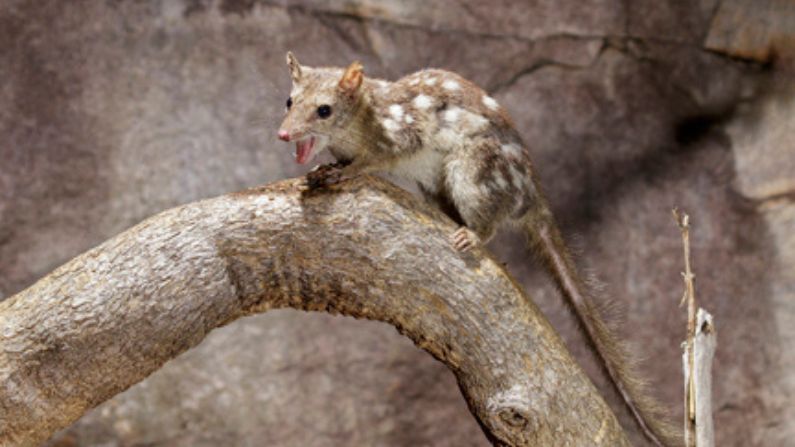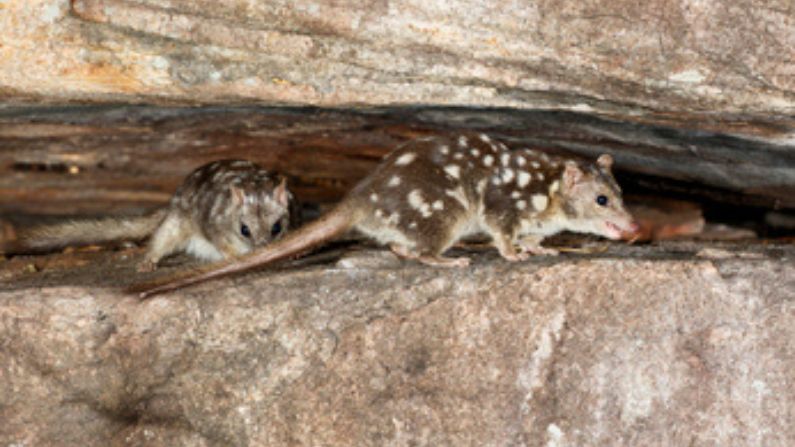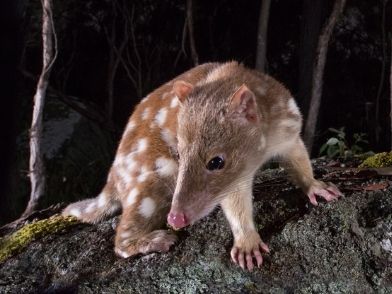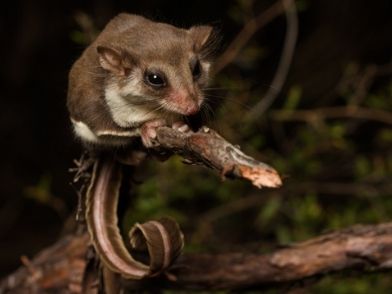Northern quoll
© Bruce Thomson/Scott Burnett
The northern quoll (Dasyurus hallucatus) is the smallest of four species of marsupial carnivore in the genus Dasyurus. Although they are the smallest of all quolls, they are the most aggressive. North Queensland is the only place in Australia where the northern quoll and spotted-tailed quoll are confirmed to occur side-by-side. The northern quoll previously occurred across most of the northern third of Australia, but its range has declined significantly.
Quick facts
COMMON NAME:
Northern quoll
ALSO CALLED: northern Australian native cat, northern native cat, satanellus, and njanmak (Mayali)
SCIENTIFIC NAME:
Dasyurus hallucatus
FAMILY:
Dasyuridae
NATIONAL CONSERVATION STATUS:
Endangered
How we help quolls
Since 2007, Wildlife Queensland’s dedicated Quoll Seekers Network has been actively surveying for spotted-tailed quolls in key locations across South East Queensland using baited remote cameras and scent detection dog surveys teams. Our survey data has been used to increase the quality and quantity of knowledge, and to raise much-needed community awareness about quolls in Queensland.
 © Mark Sanders/EcoSmart
© Mark Sanders/EcoSmart
Did you know?
The northern quoll was first described in 1842 and given the species name hallucatus, which means ‘notable first digit’. This refers to the short ‘thumb’ on the hindfoot, which aids in gripping and climbing.
 © Mark Sanders/EcoSmart
© Mark Sanders/EcoSmart
Threats to the northern quoll
- Poisoning by eating cane toads — cane toads now occur throughout all of the quoll’s distribution in Queensland and are spreading westwards across the north of Australia.
- Predation and competition from feral predators.
- Inappropriate fire regimes that alter habitat and cover.
- Habitat loss.
- Habitat degradation by trampling and grazing.
- Weeds disadvantage quolls because they inhibit movements and hunting, and foster inappropriate fire regimes.
- Road deaths.
- Isolation makes populations more vulnerable to disease and local extinction (particularly given the males’ semelparous nature).
Home range
- Territorial and solitary.
- Capable of long-range movements in relatively short periods.
- Home ranges average around 35ha for both sexes during the non-breeding season. The males’ home range may increase to more than 100ha during the breeding period.
Distribution
- In Queensland, found from about Cooktown to Rockhampton with core populations in rocky and/or high rainfall areas.
- Northern quolls also occur on a number of offshore islands in the Northern Territory and Western Australia.
Description
- The coat is grey to brown with distinctive white spots. No spots on the tail.
- 5 toes on hindfoot, short hindfoot (< 57 mm), ridged pads on the sole of the foot are a distinguishing feature.
- Body length 25–37 cm; tail length 20–35 cm (usually less than 50 cm total from nose to tail tip).
- Weight 240–1120 g (usually less than 1 kg).
- Males are larger than females.
Signs
- Scats
- On conspicuous high places on rock piles or boulders, and at den entrances.
- Usually twisted and pointed at one end.
- Contain fragments of insects, bones, fur and feathers.
- Small, approximately 10 mm x 30 mm.
- Tracks
- Hard to see in rocky and forested terrain that is the common habitat.
- Tracks can be seen in the sand.
Habitat
- Rocky areas are prime habitat for northern quolls.
- A broad range of dry sclerophyll and dry vine thickets also provide suitable habitat.
- Daytime den sites include rocky outcrops, rock piles, caves, tree hollows, hollow logs, termite mounds, goanna burrows, woodpiles and in human dwellings including ceilings, wall cavities and even inside couches.
Ecology
Life history
Most northern quoll males die at the age of about 12 months, after the short, synchronised breeding period (this species is the largest animal to be semelparous – the males reproduce only once, usually followed by death. Fewer than 30 per cent of females survive into their 2nd year.
Breeding
- Northern quolls breed once a year; late July to late August (in Queensland).
- Up to 8 young born at a time. Begin dispersing during November and December.
- Timing of reproduction, although semelparous, varies between sites and years.
Food
- Opportunistic predators and scavengers on a range of food including fleshy fruit (figs, native grapes), insects and other invertebrates, amphibians, small reptiles, small birds and rodents, and carrion.
- Has been known to eat biscuits from pet bowls, and even eat avocados from fruit bowls.




